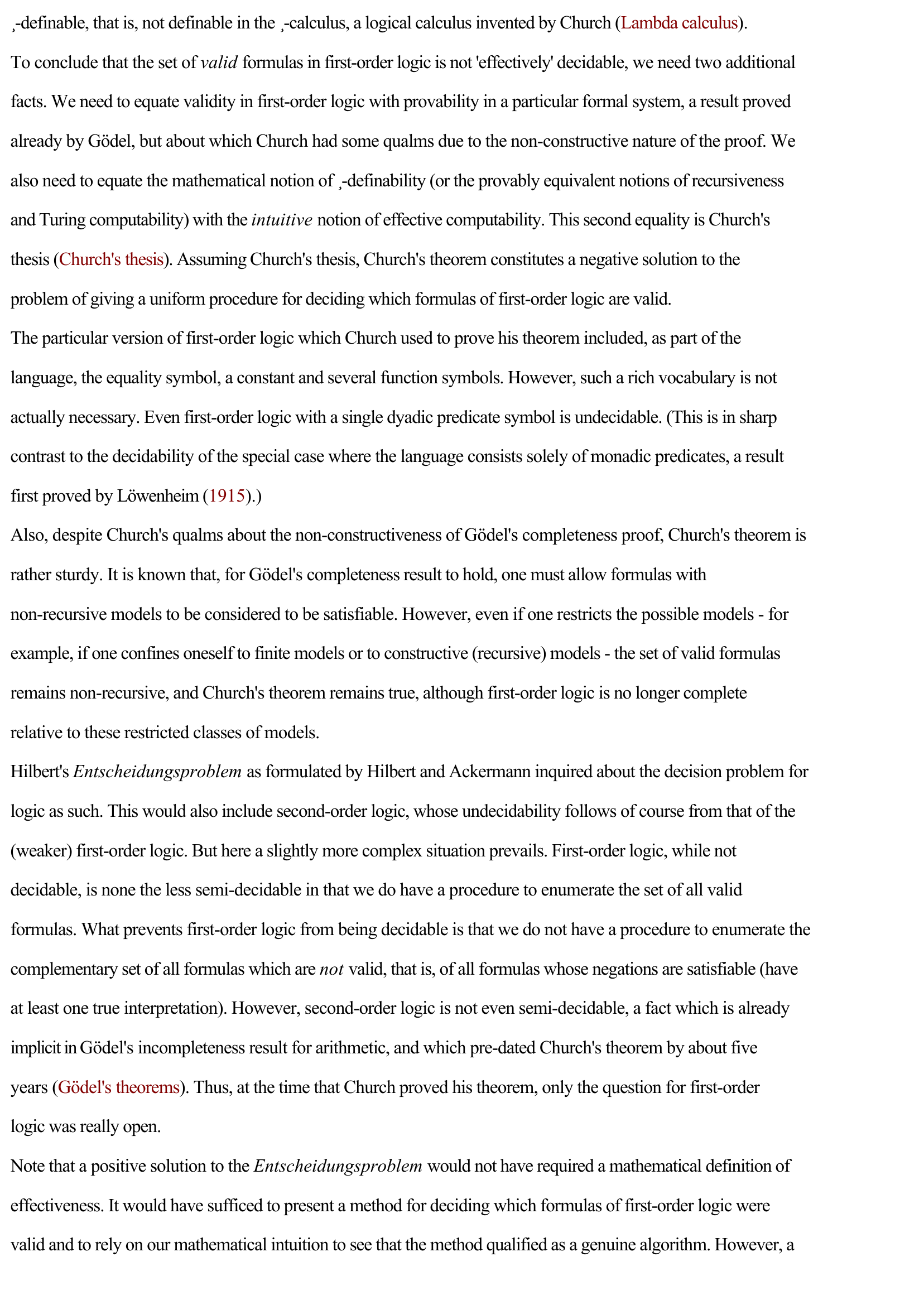Church's theorem and the decision problem
Publié le 22/02/2012
Extrait du document
«
¸-definable, that is, not definable in the ¸-calculus, a logical calculus invented by Church ( Lambda calculus ).
To conclude that the set of valid formulas in first-order logic is not 'effectively' decidable, we need two additional
facts.
We need to equate validity in first-order logic with provability in a particular formal system, a result proved
already by Gödel , but about which Church had some qualms due to the non-constructive nature of the proof.
We
also need to equate the mathematical notion of ¸-definability (or the provably equivalent notions of recursiveness
and Turing computability) with the intuitive notion of effective computability.
This second equality is Church's
thesis ( Church's thesis ).
Assuming Church's thesis, Church's theorem constitutes a negative solution to the
problem of giving a uniform procedure for deciding which formulas of first-order logic are valid.
The particular version of first-order logic which Church used to prove his theorem included, as part of the
language, the equality symbol, a constant and several function symbols.
However, such a rich vocabulary is not
actually necessary.
Even first-order logic with a single dyadic predicate symbol is undecidable.
(This is in sharp
contrast to the decidability of the special case where the language consists solely of monadic predicates, a result
first proved by Löwenheim (1915 ).)
Also, despite Church's qualms about the non-constructiveness of Gödel's completeness proof, Church's theorem is
rather sturdy.
It is known that, for Gödel's completeness result to hold, one must allow formulas with
non-recursive models to be considered to be satisfiable.
However, even if one restricts the possible models - for
example, if one confines oneself to finite models or to constructive (recursive) models - the set of valid formulas
remains non-recursive, and Church's theorem remains true, although first-order logic is no longer complete
relative to these restricted classes of models.
Hilbert's Entscheidungsproblem as formulated by Hilbert and Ackermann inquired about the decision problem for
logic as such.
This would also include second-order logic, whose undecidability follows of course from that of the
(weaker) first-order logic.
But here a slightly more complex situation prevails.
First-order logic, while not
decidable, is none the less semi-decidable in that we do have a procedure to enumerate the set of all valid
formulas.
What prevents first-order logic from being decidable is that we do not have a procedure to enumerate the
complementary set of all formulas which are not valid, that is, of all formulas whose negations are satisfiable (have
at least one true interpretation).
However, second-order logic is not even semi-decidable, a fact which is already
implicit in Gödel's incompleteness result for arithmetic, and which pre-dated Church's theorem by about five
years ( Gödel's theorems ).
Thus, at the time that Church proved his theorem, only the question for first-order
logic was really open.
Note that a positive solution to the Entscheidungsproblem would not have required a mathematical definition of
effectiveness.
It would have sufficed to present a method for deciding which formulas of first-order logic were
valid and to rely on our mathematical intuition to see that the method qualified as a genuine algorithm.
However, a.
»
↓↓↓ APERÇU DU DOCUMENT ↓↓↓
Liens utiles
- George Frideric Handel I INTRODUCTION Handel's Water Music In addition to his popular operas and oratorios, German-born composer George Frideric Handel wrote music in the 1700s for the church and for royal celebrations.
- Statistics I INTRODUCTION Statistics, branch of mathematics that deals with the collection, organization, and analysis of numerical data and with such problems as experiment design and decision making.
- Statistics I INTRODUCTION Statistics, branch of mathematics that deals with the collection, organization, and analysis of numerical data and with such problems as experiment design and decision making.
- A SIMPLE SOLUTION TO AN IMPOSSIBLE PROBLEM The day after the renter and I dug up Dad's grave, I went to Mr.
- Ideology and Rationality in the History of the Life Sciences

































